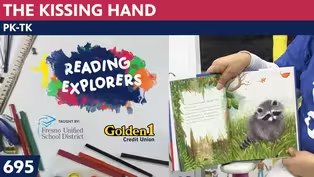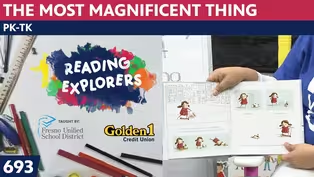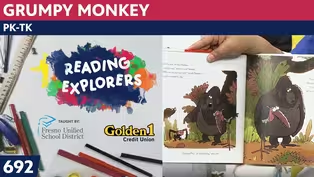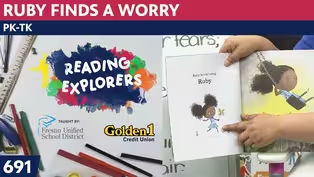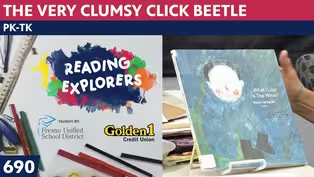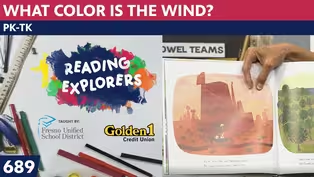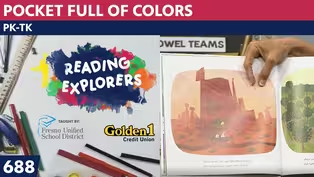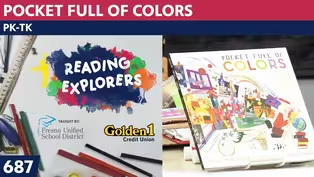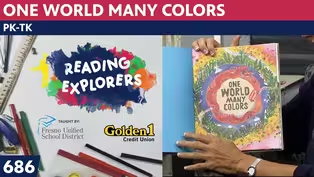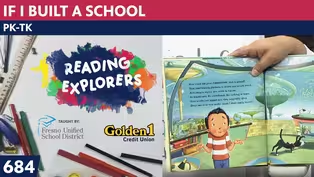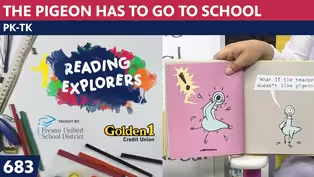
TK-355: Jackson Pollock
Season 3 Episode 306 | 14m 11sVideo has Closed Captions
Join Mrs. Readwright at Camp Discovery!
Transitional Kindergarten teacher, Mrs. Readwright, welcomes students back to Camp Discovery, a fun learning space packed with reading adventures & fun games!
Problems playing video? | Closed Captioning Feedback
Problems playing video? | Closed Captioning Feedback
Reading Explorers is a local public television program presented by Valley PBS

TK-355: Jackson Pollock
Season 3 Episode 306 | 14m 11sVideo has Closed Captions
Transitional Kindergarten teacher, Mrs. Readwright, welcomes students back to Camp Discovery, a fun learning space packed with reading adventures & fun games!
Problems playing video? | Closed Captioning Feedback
How to Watch Reading Explorers
Reading Explorers is available to stream on pbs.org and the free PBS App, available on iPhone, Apple TV, Android TV, Android smartphones, Amazon Fire TV, Amazon Fire Tablet, Roku, Samsung Smart TV, and Vizio.
Providing Support for PBS.org
Learn Moreabout PBS online sponsorshipMore from This Collection
Valley PBS and Fresno Unified School District have partnered with Golden 1 Credit Union to create Reading Explorers Lessons for grades Pre-Kindergarten through Third grade. The daily lessons will be taught by Fresno Unified School District teachers and are created to help students practice their reading skills and reinforce lessons during distance learning.
Video has Closed Captions
Valley PBS presents Reading Explorers Lessons for Pre-Kindergarten and TK. (26m 27s)
PK-TK-693-The Most Magnificent Thing
Video has Closed Captions
Valley PBS presents Reading Explorers Lessons for Pre-Kindergarten and TK. (26m 26s)
Video has Closed Captions
Valley PBS presents Reading Explorers Lessons for Pre-Kindergarten and TK. (26m 28s)
Video has Closed Captions
Valley PBS presents Reading Explorers Lessons for Pre-Kindergarten and TK. (26m 28s)
PK-TK-690: The Very Clumsy Click Beetle
Video has Closed Captions
Valley PBS presents Reading Explorers Lessons for Pre-Kindergarten and TK. (26m 22s)
PK-TK-689: What Color is the Wind?
Video has Closed Captions
Valley PBS presents Reading Explorers Lessons for Pre-Kindergarten and TK. (26m 21s)
PK-TK-688: Pocket Full of Colors
Video has Closed Captions
Valley PBS presents Reading Explorers Lessons for Pre-Kindergarten and TK. (25m 58s)
PK-TK-687: Dancing Through Fields of Colors
Video has Closed Captions
Valley PBS presents Reading Explorers Lessons for Pre-Kindergarten and TK. (26m 20s)
PK-TK-686: One World Many Colors
Video has Closed Captions
Valley PBS presents Reading Explorers Lessons for Pre-Kindergarten and TK. (27m 13s)
PK-TK-685: School is Wherever I am
Video has Closed Captions
Valley PBS presents Reading Explorers Lessons for Pre-Kindergarten and TK. (26m 32s)
PK-TK-684: If I Built a School
Video has Closed Captions
Valley PBS presents Reading Explorers Lessons for Pre-Kindergarten and TK. (26m 21s)
PK-TK-683: The Pigeon Has to Go to School
Video has Closed Captions
Valley PBS presents Reading Explorers Lessons for Pre-Kindergarten and TK. (26m 22s)
Providing Support for PBS.org
Learn Moreabout PBS online sponsorship♪ Good morning to a brand new day ♪ ♪ Time to learn and games to play ♪ ♪ Learning things is so much fun ♪ ♪ Learning is good for everyone ♪ (upbeat music) - Hello, early learners.
It's me, Mrs. Readwright, back in the Art Room where we are doing the ABC's of art.
I want to say hello quickly to my last few students that are watching at Lawless Elementary with their teacher, Mrs. Nersesian.
I wanted to say hello to Delisaih, Moses and Gernoire.
Thank you for joining us.
Thank you for doing art with us, and continuing with your art projects.
Make sure you send them to the studio with your home address, because we'll send home a book of activities.
All right, so, let's do some make some noise.
And I had out this funny thing that I was looking for when we did our weather unit.
And it's painted with van Gogh's Starry Night.
But listen, it's a thunder instrument.
(thundering) So I'll say, ♪ Let's make some noise ♪ ♪ We girls and boys ♪ ♪ We've got a voice ♪ ♪ So let's make some noise ♪ (thundering) And back into the instrument box it goes.
Boys and girls, let's sing the ABCs of Art song for the last time this week.
We still have letter Z that we're going to start the next time.
So here we go.
♪ A, B, C, D, E of art ♪ ♪ That's the way that we will start ♪ ♪ U for umbrella ♪ ♪ Violin for V ♪ ♪ W for window, we can see ♪ ♪ X is for Xs ♪ ♪ Y yarn squiggles for me ♪ ♪ Warhol, Zebra and the alphabet with Z ♪ So we are meeting Jackson Pollock.
Now, we haven't ever studied him in the past.
And he died three years after I was born.
So when I was three years old I could have seen his artwork at a museum.
And here he is, he's happy about his art.
And some people called him Jackson and some people called him Jack.
And he was known as Jack the Dripper, because many of his most famous artworks look like this.
Look at this art.
It looks like he just held the paint above the paper and dripped it.
And you know what?
He did, he dripped it, he used different tools, he did dip some things in and dripped them and made thicker drips.
And I thought it looked like yarn.
And that's why I chose it for the letter Y.
Because I thought there were other pictures that had yarn in them, but I thought this looked like yarn.
And you know what?
You could dip yarn into buckets of paint or cups of paint and lay it on the paper and then pick it up and it would look just like yarn, if that's what you would like.
Now, I'm warning you right now, this is not an inside project.
This is a project for outside on the patio.
So today, let's just watch, and you can see some of the things I am using for my painting tools.
Let me pick up my little table.
I am only using brown, black, and white paint on my tan paper because this painting is called Number 30.
He named it after number 30.
So I put it in a box, because if you've ever been at school and your teacher lets you put a marble in paint and then roll the box around like this, and it will roll around, it will look kind of like Jackson Pollock's work.
But I also brought a fork I could put in and drip.
But I think I need to add a little water to make the paint kind of drippy.
So I'm gonna pour a little water in each of these and hope for the best.
I thought I'd do the black last because the black kind of adds, oh, it's really not drippy enough, I'm gonna have to add a lot more water.
I hope the white paint doesn't get all mixed in with the black because it's going downhill.
(scraping) All right.
You can see, I keep squeezing more and more water.
'Cause I want it to get on the fork, and then just start dripping into the painting.
Oh, it's drips.
I might have to draw my fork across to make the paint go.
I'm still adding more.
Oh, I like how that looks.
So it kind of looks like drips.
I'm moving it around.
I wonder if you can see 'cause it's in this box kind of at an angle.
Let me add some brown and see what it looks like there.
(scraping) And I'm going to do some drip.
Oh, I like it better as a printmaking.
I think the paint won't drip enough until I start to pour it from the black paint bucket.
But do you see how it looks like yarn, kind of?
Do any of you have marbles that you can put in a bucket of paint?
And I'm going to show you how I'm doing that.
And it will mix up, the black paint will mix with any brown that I've already put on here.
Now, look, here's my marble.
And it's a big boulder one.
And I'm going to put it on my spoon and put it in this little container of paint and mix it around.
And when I put it on my paper, I put it in the corner of the box rather than onto the paper, because if I put it on the paper it leaves a big glob.
And I'm putting it in this corner and I'm gonna roll it across, and you can see what happens when it rolls across, it picks up some of the brown and white paper.
And I'm just rolling it around like this and it ran out of black paint.
So I'll get it back in this corner.
I'll pick it up with my spoon again, put it in the black paint, and stir it around, and let it roll around again.
Where do I put it, boys and girls?
On the paper or in the corner?
That's right, in the corner.
And I will let it roll again.
Roll on little ball!
Ooh, ooh!
One time we got the lid to a giant refrigerator box and four children got around the edges of the box and rolled around a ball, and it was a big, giant painting.
I think I like my one where I drag the fork across.
I'm going to move this back into the paint and I'm going to do more white, because I think it needs more.
It's making some tan because when you mix brown and white paint together, it makes it kind of a tan color.
I might make some swirls too.
Anytime it goes over another color it makes it a little different.
Can you see why we decided we needed to put this in the backyard to do this or in the garage?
Now that I've mixed enough water in this paint, I can pour some.
I'm going to do it.
Watch as I do this.
'Cause then it makes it drippy.
And I can be like Jack the Dripper.
Some of it is swirling.
Oh, here comes some of the black, and it's going all over.
And sometimes you think, have I done enough?
And when you see that you've done enough, don't go too far 'cause then it just looks a mess.
Although he stood up and he would even pour buckets of paint and throw them across his paints, and it would make it all exciting that way.
There we go.
I think that I have done enough on this painting.
I think that this has gotten enough paint on it and I need to leave it standing straight up, because it will start dripping across my paper, and I want to let it dry that way.
I wanted to show you this book I brought for Jackson Polluck.
It's called "Jackson Polluck Splashed Paint And Wasn't Sorry".
'Cause sometimes if you accidentally splash paint and it damages something, you say, oh, I'm sorry, but he wasn't sorry, it was his idea.
He was known for this.
If you see him working on art, there are videos of him working on the art, and he almost always had a cigarette.
In those days they didn't know the cigarette was making people's lungs feel bad.
But he was smoking a cigarette and throwing paint and splattering things.
But this one has a cartoon picture of someone and it's to represent Jackson Pollock.
And I wanted to show you a couple of things in here as I take this cover off this book so that it doesn't get paint on it.
Take a look.
This tells you it's Jackson, Jack the Dripper.
These shoes belonged to Jackson Pollock.
Take a look at them.
They are covered with paint.
Now that's why we say do the project outside because it will get on your clothes if you're not careful.
And here he is as a painter, when he was living in New York City.
And people knew about him as an artist and it was a great city and he met Lee and Peggy, some friends, and they let him stay at their place.
And he moved out to the countryside.
After that he found peace and inspiration where he was painting.
And he didn't like standing in front of an easel with a brush, and that's why he decided he was going to do the kind of dripping paint.
So, he just lined up his bucket of paints, and he put them at his feet and he would find colors that were analogous.
And those are the ones in the color wheel, the ones that are right next door to each other.
So he might use red and orange.
Because those two are the next order in the rainbow of the color wheel.
And did he paint doing somersaults?
It looked like it.
And sometimes he did.
He put his hands on the ground, lifted one hand up and would drip it over.
He even had a sling that he sat on that was like a swing, and he would hold paint and he would swing across and he would paint that way.
His friends thought he was an interesting show to watch.
He even painted while he ran across the top of the canvas.
Jackson Pollock, people say they think that they could do the work, but his paintings sell for millions of dollars, girls and boys.
So, they think that he might've been able to paint by being on a wheeled instrument.
Maybe on a bicycle and just hold the paint out, because his canvases were gigantic!
I hope you look on the internet and find a film that shows him painting because he is so small next to the canvas that's out on the ground.
Look, they think he even did some painting while he was dancing the jitterbug like we saw with William Johnson.
They think, could he have climbed up on top of chairs to paint?
Would he have climbed a mountain and poured paint down below?
Would this be a good place to be on a parachute and hanging down and having paint hit the paintings below?
Oh, that's like Ms. Alaras dropping her egg with a little parachute.
They thought he could do his painting by swimming in a river.
Well, boys and girls, we've gotten all the way to the letter Y.
We will start Z on our next show.
And then, you know what I decided to do?
I'm going to do the one, two threes of art.
So be ready to do that.
And then we're going to study birds.
So I hope that you'll have a great weekend and I'm going to sing goodbye to all my friends.
♪ Oh, it's time to say goodbye to all my friends ♪ ♪ Oh, it's time to say goodbye to all my friends ♪ ♪ Oh, it's time to say goodbye ♪ ♪ Give a smile and wink your eye ♪ ♪ Oh, it's time to say goodbye to all my friends ♪ All right, so, with my Jackson Pollock painting, I will let it dry.
Make sure you let yours dry someplace where it's not near your furniture.
And I will bring back all of my art that's completed and you'll see all of it the next time we are together.
Thank you for joining me.
Remember to send me pictures or letters, and I will enjoy opening those and reading them.
See you next time, boys and girls.
Bye bye.
(upbeat music) ♪ Good morning to a brand new day ♪ ♪ Time to learn and games to play ♪ ♪ Learning things is so much fun ♪ ♪ Learning is good for everyone ♪
Support for PBS provided by:
Reading Explorers is a local public television program presented by Valley PBS
